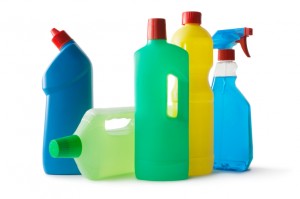6 Dangerous Chemicals in Cleaning Products and How to Avoid Them

With spring cleaning season in full swing, products like disinfectants and air fresheners are at the top of the shopping list for many people. Before you get going with your deep clean though, it’s important to educate yourself on the potentially dangerous chemicals that are found in many cleaning products.
From minor issues like skin redness to serious concerns like neurological damage, the substances in these products can pose many health risks, not only to you but to your pets and loved ones as well.
Some of the most common ones include:
Toxic chlorine/chloramine gases –
Although these gases aren’t ingredients per se, they can result from the combination of products containing chlorine (like bleach) and ammonia or lye and ammonia. Be careful never to let these two types of products come into contact with one another, and if they do, leave the room and open a window so it can air out.
Fragrances –
Many people are surprised to find that the fragrances which smell so good can pose a health risk. Butane and propane, two propellants used in air fresheners, are flammable and can be inhaled after the fragrance is sprayed. Plus, even natural fragrances like citrus can react and become dangerous when combined with certain other ingredients, so it’s best to use only pure substances like essential oils and sachets of dried flowers.
Diethanolamine (DEA) and triethanolamine (TEA) –
These sudsing agents are used in a wide variety of cleaning products, but when they come into contact with nitrates, which can be used as preservatives, they can form carcinogens called nitrosamines.
1,4-dioxane –
This suspected carcinogen is often found in cleaners that contain ethoxylated alcohols and can damage the central nervous system, liver and kidneys.
Butyl cellosolve aka ethylene glycol monobutyl ether –
As a suspected neurotoxin, this chemical may damage the brain and nervous system.
Alkylphenol ethoxylates (APEs) –
Often used in detergents and cleaners, these substances may mimic estrogen in the body and cause hormonal disruptions, lowered sperm counts, and more.
Because companies aren’t legally required to disclose all ingredients on the labels of their products, it can be difficult to know for sure which products are safe and which aren’t. For the ones that do list ingredients, you can compare against the list of common chemicals above to assess safety. However, you may also want to look into making your own safe, natural alternatives such as a vinegar and water glass cleaning solution or baking soda-based oven cleaner.
About the author: Mario Cattabiani is the Director of Communications at Ross Feller Casey, LLP, a personal injury and medical malpractice law firm based in Philadelphia, nationally recognized as birth injury lawyers.
Tags: cleaning, safety
